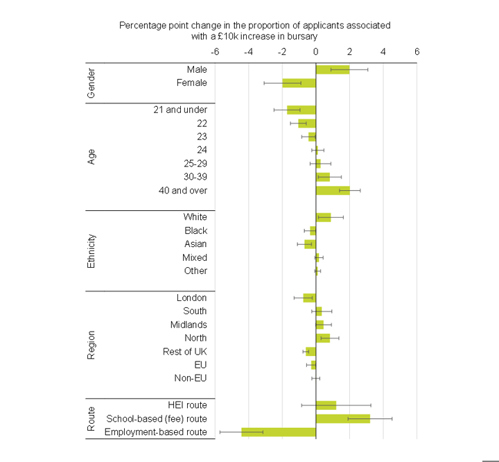Do bursaries change who applies to teacher training?
Wednesday 24 November 2021

This article was first published in Teaching Times on Wednesday 24 November 2022.
NFER School Workforce Lead Jack Worth and Emma Hollis, Executive Director of the National Association for School-Based Teacher Trainers (NASBTT) explain the key findings from their new research on the effect bursaries have on the characteristics of teacher training applicants and reflect on their importance for equality in teaching and future bursaries policy.
Bursaries for postgraduate initial teacher training (ITT) are a key policy tool, used by government to attract more people to enter teacher training, particularly for high-priority subjects that might otherwise struggle to recruit enough teachers. Bursaries also represent a significant amount of government expenditure: up to £129 million for the 2022/23 trainee teacher cohort.
Research on the impact of bursaries has tended to focus on the effect on trainee numbers. However, relatively little research has focussed on the impact on the type of applicants who apply to teacher training, and the implications for diversity and equality in the teaching profession.
Our new analysis of data from the Universities and College Admissions Service (UCAS) reveals that while increases in bursaries do tend to lead to more applicants, they also change the composition of applicants. While bursary increases are associated with increases in the number of applicants across all groups, some are more responsive to financial incentives than others, which changes the proportions of applications with different characteristics.
We find that bursary increases are associated with a greater proportion of male and white applicants, career changers and those from the north of England, and a smaller proportion of applications to employment-based training routes.

There are six key findings from the analysis, many of which have important implications for policy making.
-
Bursaries incentivise more applications
In years when the bursary for a subject was higher than other years, the number of applications tended to be higher, on average. We estimate that a £10,000 increase in bursary is associated with a 29 per cent increase in applications. As NFER reported in the spring, the reverse is also true: bursary reductions can be used to dampen demand for subjects that would otherwise recruit more teachers than are required.
The analysis confirms DfE internal analysis, reported by the National Audit Office in 2016, which showed ‘a statistical link between bursaries and the number of applications to train’ with exactly the same level of responsiveness.
Important and unanswered questions remain about the long-term effectiveness of bursaries at attracting teachers who enter the state sector and stay in teaching, and also about the cost effectiveness of bursaries. However, the short-term effectiveness of bursaries at increasing interest in teacher training seems beyond doubt.
-
Bursaries particularly attract career changers
There is a significant relationship between age and bursary value, with older applicants being more responsive to higher bursary values. We estimate that a £10,000 bursary increase is associated with a two percentage point increase in the proportion of applicants who are age 40 and over. While the number of applicants aged 21 and under increases slightly in response to a bursary increase, the proportion of applicants in this age group is two percentage points lower when the bursary is £10,000 higher.
Older applicants are more likely to be career changers, suggesting that bursaries are an important aspect of enabling career changers to leave an existing job to enter teaching, by providing a financial cushion. Perhaps financial factors are relatively more important for older applicants due to financial commitments that come with age.
It is a significant finding for policy, since research has shown that older teacher trainees tend to have lower retention rates. Older entrants are also likely to have shorter careers because they are closer to retirement. Both of these factors may suggest that while bursaries may attract more applicants in the short-term, they may attract types of applicants that are less likely to stay in teaching for a long period.
-
Bursary increases appear to decrease the proportion of BAME applicants
A £10,000 bursary increase is associated with a one percentage point increase in the proportion of applicants who are white. We estimate small, but statistically significant, associations between a bursary increase and decreases in the proportion of applicants who are black and Asian. The number of applicants across all groups increases in response to a bursary increase, but it is white applicants that are most responsive to the change.
There is increasing interest in promoting measures to improve racial equality in the teaching workforce and address the under-representation of black Asian and minority ethnic (BAME) teachers. NFER is currently undertaking a research study with Ambition Institute and Teach First to take an in-depth look at how racial equality in teacher workforce can be improved.
There are some concerns from research that financial constraints to entering teaching may be greater for BAME trainees, which may suggest that bursaries could disproportionately enable potential BAME trainees to apply. However, our analysis suggests that simply increasing bursaries is unlikely on its own to help achieve the goal of equalising opportunities to enter the teaching profession by ethnicity.
-
Employment-based routes tend to lose out from bursary increases
A £10,000 higher bursary in a subject is also associated with a four percentage point reduction in applications to employment-based routes (School Direct salaried and postgraduate teaching apprenticeships). Indeed, a higher bursary is even associated with a decrease in the number of applications, suggesting that bursaries seemingly encourage people to switch to other routes.
There is a three percentage point increase in the proportion of applicants applying to school-based, fee-paying routes associated with a higher bursary, while the association with the proportion of applicants applying to Higher Education Institution (HEI)-based routes is not statistically significant.
This is likely to reflect the bursary enabling trainees to choose to forego the salary associated with employment-based routes, and instead to focus more time on engaging with the ITT programme without the need to be a timetabled teacher alongside.
-
Men are more responsive to bursaries than women
The analysis shows that a £10,000 bursary increase is associated with a two percentage point increase in the proportion of male applicants.
This suggests that men are more responsive to changes in bursaries than women, which could be due to a greater responsiveness by men to financial factors in their occupational choices, relative to non-financial factors. This has also been found in relation to male and female responsiveness to relative teacher pay (e.g. see Dolton, Tremayne and Chung, 2003).
Research has also shown that male trainees tend to have lower retention rates. As with career changers, this suggests that bursaries may attract types of applicants that are less likely to subsequently stay in teaching.
-
London-based applicants are less responsive to bursaries than other regions
A higher bursary in a subject is associated with a smaller proportion of applicants coming from London and a greater proportion from the north of England. This suggests that financial factors may be relatively more important for teacher training applicants in the north of England compared to in London. It may also reflect the greater value of the same nominal monetary value, given differences in the cost of living between the north of England and London.
DfE research suggests that London tends to recruit fewer teachers than it needs and the North West tends to recruit more than it needs. Our analysis suggests that bursary increases tend to heighten this divide rather than address it.
Conclusions
Overall, the evidence from this analysis suggests that while bursaries tend to attract more people into ITT than otherwise would have entered, they also change the characteristics of those who apply. In some cases, these composition changes from bursary increases promote greater equality (e.g. increasing the proportion of men) while in others it appears to reduce it further (e.g. reducing the proportion of BAME trainees).
In cases like the high responsiveness of career changers and men to bursary changes, the findings suggest that bursaries tend to attract types of applicant that are less likely to stay in teaching for a long period. Indeed, more research is needed to understand the longer-term effectiveness of bursary changes, assessing the number of teachers who enter and are ultimately retained in teaching, rather than simply the numbers recruited.
Acknowledgements
Many thanks to UCAS for making the data available for analysis and to NASBTT for securing access to the data and supporting this research.
Methodology note
We use subject-level data on applications to postgraduate ITT courses in England from UCAS. The data covers the 2013/14 to 2019/20 recruitment cycles, and includes applications to higher education institutions (HEIs), school-centred ITT (SCITT) and School Direct providers as well as postgraduate teaching apprenticeships. It does not include applications to the teacher training programme run by Teach First, nor to undergraduate programmes.
We combine this with data on the postgraduate ITT bursary that applicants to each subject were eligible for, gathered from the DfE website. Where the bursary payment varied according to degree class, we took the value of bursary that a graduate with a 2:1 degree would have been eligible for, as this was the most common degree class.
We explore the association between the level of bursary offered and the characteristics of applicants using a statistical regression model. The outcome variable is the proportion of applicants to a subject in a year with a certain characteristic and the dependent variable is the bursary value. One model is separately estimated for each characteristic.
Crucially, the analysis uses two-way fixed effects, which is more robust than simply comparing between subjects with different levels of bursary.
First, the analysis compares within subjects using subject fixed effects. Comparing high-bursary, majority-male physics with low-bursary, majority-female English (i.e. between subjects) may lead to drawing misleading conclusions about the impact of bursaries on the gender balance of applicants. This is because there are a range of other subject-specific factors that could by driving differences in bursaries and gender. Instead the analysis compares the gender balance within each subject when the bursary was lower with the gender balance within the same subject when the bursary was higher. By accounting separately for subject-specific factors, the association is more likely to reflect the causal impact of the bursary on the composition of applicants.
The analysis also separately accounts for all the year-to-year factors that affect all subjects uniformly. Year fixed effects account for the influence of all observed and unobserved factors that are specific to a particular year and that are common across subjects. These factors may include teacher pay, the state of the economy and changes in the overall number of graduates. For example, when exploring the bursary effect on the number of applicants, the model accounts separately for the increase in applications across all subjects that occurred in 2020 due to the pandemic and recession.
The estimates are weighted according to the total number of applicants to each subject, to account for the fact that smaller subjects may introduce disproportionately more ‘statistical noise’ into the analysis.
